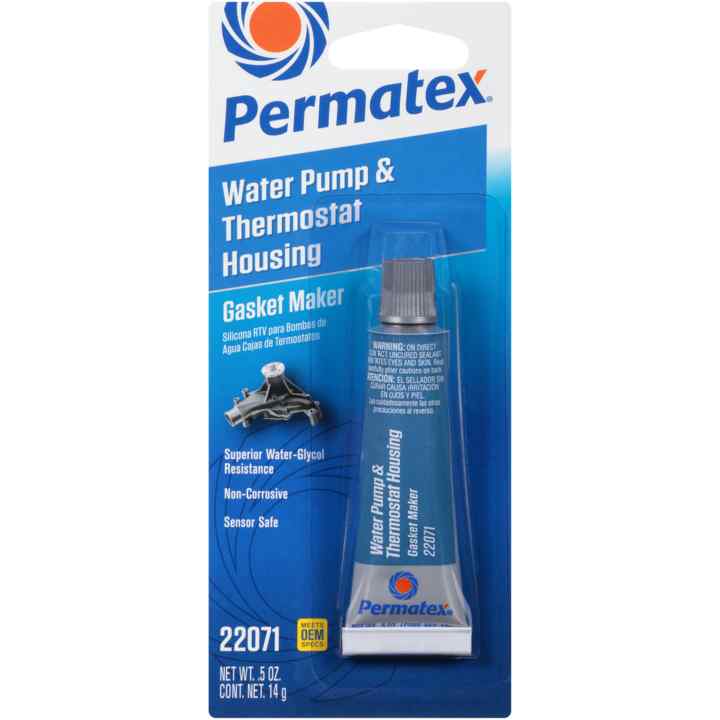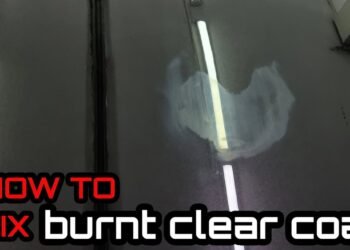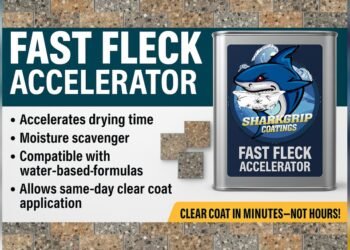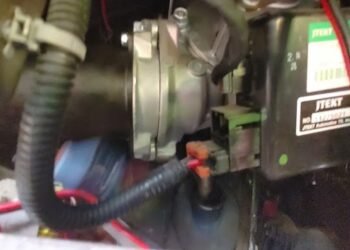If you’re planning to replace or install a water pump on your vehicle, you might be wondering whether you should use RTV sealant on the water pump gasket. You want a leak-free, durable seal that stands up to engine heat and vibrations.
But is slathering on RTV the right move, or could it actually cause more harm than good? You’ll discover when RTV sealant is truly necessary, when it’s best to skip it, and how to apply it correctly if you do choose to use it.
Keep reading to make sure your water pump gasket seals perfectly the first time—saving you from costly leaks and headaches down the road.
When Rtv Is Not Needed
RTV sealant is not always necessary for water pump gaskets. Many water pump installations rely solely on the gasket material for a proper seal. Using RTV where it is not needed can cause leaks or gasket failure. Understanding when to skip RTV helps ensure a secure and lasting fit.
Standard Gasket Installation
Most water pumps come with a gasket designed to seal without extra sealant. The gasket fits tightly between the pump and engine block. Installing a new gasket alone usually creates a strong, leak-proof seal. Adding RTV can disrupt this fit and cause problems.
Always check the manufacturer’s instructions. They often recommend no sealant for standard gaskets. Proper bolt torque and clean surfaces are key to a good seal. Skip RTV unless the surface has damage or special needs.
Rubber And Silicone Gaskets
Gaskets made with rubber or silicone layers do not need RTV. These materials provide their own sealing properties. Applying RTV over these gaskets can interfere with their function. It may cause the gasket to slip or lose its shape.
When using rubber or silicone gaskets, simply align and install them carefully. Avoid any extra sealant to maintain gasket integrity. This approach keeps the seal tight and prevents leaks.

Credit: www.amazon.com
When To Use Rtv With Caution
Using RTV (Room Temperature Vulcanizing) sealant on a water pump gasket requires care. It is not always safe or effective. Incorrect use can cause leaks or damage. Knowing when to use RTV cautiously helps protect your engine. Below are key situations to watch for.
Damaged Mounting Surfaces
RTV can fill small gaps on scratched or pitted surfaces. Apply only a thin layer to avoid excess sealant. Too much RTV may prevent proper gasket seating. Use a specialized water pump RTV designed for coolant systems. This helps maintain a good seal despite surface flaws.
Gasket Retention During Installation
A light coat of RTV on the water pump side can hold the gasket in place. This prevents shifting or rolling while installing the pump. Avoid putting RTV on the engine block side. Proper gasket alignment reduces leaks and simplifies assembly.
Metal Crush Gaskets
These gaskets seal by being compressed by bolts. RTV is not needed and may interfere with the seal. Using RTV here can cause gasket failure or leaks. Always follow manufacturer instructions for metal crush gasket installation.
Sealant Application Tips
Applying RTV sealant on a water pump gasket requires careful attention to detail. Proper application ensures a strong, leak-free seal. Following specific steps helps avoid common sealing problems and engine damage. Use these sealant application tips for best results.
Cleaning Mating Surfaces
Start by cleaning both mating surfaces thoroughly. Remove all old gasket material, dirt, and oil. Use a scraper or wire brush gently to avoid damaging the metal. Clean surfaces help RTV adhere better and prevent leaks.
Avoid Rtv On Engine Block
Do not apply RTV directly on the engine block surface. RTV can cause uneven sealing and damage the block. Instead, apply it sparingly on the water pump side if needed. This keeps the engine block safe and ensures a proper seal.
Choosing The Right Rtv
Select RTV designed for water pumps and coolant systems. Use a high-quality, heat-resistant sealant like Permatex Water Pump & Thermostat RTV. Avoid general-purpose RTVs that may not withstand engine temperatures or chemicals.
Applying Rtv Sparingly
Apply a thin, even bead of RTV. Too much sealant can squeeze out and block coolant passages. A small amount fills minor surface imperfections without causing excess mess. Let RTV cure according to the product instructions before assembly.
Correct Bolt Torque Pattern
Tighten bolts in a crisscross or star pattern. This ensures even pressure on the gasket and sealant. Use a torque wrench to reach the manufacturer’s recommended torque. Uneven tightening can cause leaks and gasket failure.

Credit: www.permatex.com
Where To Apply Rtv
Knowing where to apply RTV (Room Temperature Vulcanizing) sealant on a water pump gasket is key for a strong seal. The right application prevents leaks and ensures the pump works well. RTV should be used carefully and only in specific areas. Misapplication can cause gasket damage or coolant leaks. Follow these guidelines for best results.
Where Rtv Should Not Be Applied
- Do not apply RTV on the gasket itself unless specified.
- Avoid RTV on rubber or silicone gaskets with built-in sealant.
- Never put RTV directly on the engine block surface if avoidable.
Where To Apply Rtv On Water Pump Housing
- Use a thin layer of RTV on the water pump housing side only.
- This helps hold the gasket in place during installation.
- Apply RTV sparingly on damaged or pitted surfaces to fill gaps.
Areas To Keep Clean Before Applying Rtv
- Clean both the water pump and engine block surfaces thoroughly.
- Remove all old gasket material and debris before applying RTV.
- Ensure surfaces are dry and free of oil or coolant residues.
Selecting The Best Rtv Product
Selecting the best RTV product is crucial for a reliable water pump gasket seal. The right RTV ensures a tight fit and prevents coolant leaks. Not all RTVs perform the same under engine heat and pressure. Choosing one designed for water pumps and thermostats improves durability and effectiveness. Understanding key properties like moisture-curing helps you pick the ideal sealant for your needs.
Water Pump And Thermostat Rtv
This type of RTV is specially formulated to handle coolant exposure and engine heat. It remains flexible after curing, preventing cracks and leaks. The RTV bonds well to metal surfaces, filling small gaps and imperfections. It also resists breakdown from antifreeze and other chemicals. Using water pump and thermostat RTV ensures a strong, lasting seal on gaskets.
Moisture-curing Properties
Moisture-curing RTV cures when exposed to air moisture, creating a tough seal. This feature allows the RTV to dry evenly and fully around the gasket. It also improves adhesion to wet or slightly damp surfaces. Moisture-curing RTV adapts to temperature changes without losing its sealing power. This property makes it ideal for automotive cooling systems exposed to heat and moisture.

Credit: www.reddit.com
Frequently Asked Questions
Do You Need Rtv For Water Pump Gasket?
You generally do not need RTV for a water pump gasket. Use the gasket alone for a proper seal. Apply a thin layer of specialized RTV only if surfaces are damaged or to hold the gasket during installation. Avoid excess RTV to prevent leaks.
Should I Use Sealant On A Water Pump Gasket?
Use sealant on a water pump gasket only if surfaces are damaged or to hold the gasket during installation. Otherwise, rely on the gasket alone. Apply RTV sparingly on the pump side, never on the engine block, and use a product designed for water pumps to avoid leaks.
What Color Rtv For Water Pump?
Use black or dark gray water pump RTV sealant designed for high-temperature coolant resistance. Apply sparingly only on damaged or uneven surfaces.
Which Permatex For Water Pumps?
Use Permatex Water Pump & Thermostat RTV only on damaged or pitted surfaces. Apply sparingly on the pump side, not the engine block. For standard gaskets, rely on the gasket alone without RTV to prevent leaks and ensure proper sealing.
What Is Rtv And Its Role In Water Pump Gaskets?
RTV is a sealant used to fill small gaps and protect against leaks in engine parts.
Conclusion
Using RTV on a water pump gasket is usually unnecessary. The gasket alone seals the pump well under normal conditions. Only apply a thin layer of specialized RTV if surfaces have damage. Always clean surfaces thoroughly before installation. Use RTV sparingly and only on the pump side, not the engine block.
This careful approach helps prevent leaks and ensures a longer-lasting seal. Proper gasket installation keeps your engine running smoothly and avoids costly repairs. Simple steps make a big difference in water pump maintenance.

















